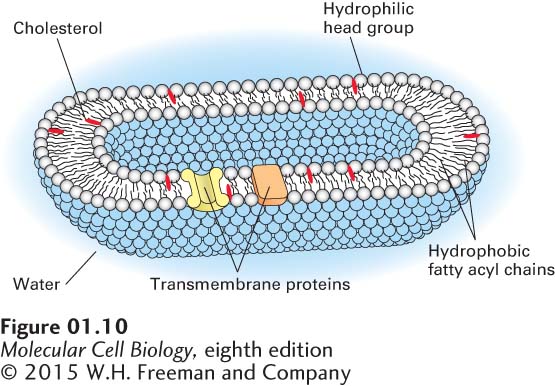Phospholipids Are the Conserved Building Blocks of All Cellular Membranes
In all organisms, cellular membranes are composed primarily of a bilayer (two layers) of phospholipid molecules. Each of these bipartite molecules has a “water-loving” (hydrophilic) “head” and a “water-hating” (hydrophobic) “tail.” The two phospholipid layers of a membrane are oriented with all the hydrophilic heads directed toward the inner or outer surfaces of the membrane and the hydrophobic tails buried within its interior (Figure 1-10). Smaller amounts of other lipids, such as cholesterol, are inserted into this phospholipid framework. Cellular membranes are extremely thin relative to the size of a cell. If you magnify a bacterium or yeast cell about 10,000 times to the size of a soccer ball, the plasma membrane is about as thick as a sheet of paper!

FIGURE 1-10 The watery interior of cells is surrounded by the plasma membrane, a two-layered shell of phospholipids. The phospholipid molecules are oriented with their hydrophobic fatty acyl chains (black squiggly lines) facing inward and their hydrophilic head groups (white spheres) facing outward. Thus both sides of the membrane are lined by head groups, mainly charged phosphates, adjacent to the watery spaces inside and outside the cell. All biological membranes have the same basic phospholipid bilayer structure. Cholesterol (red) and various proteins are embedded in the bilayer. The interior space is actually much larger relative to the volume of the plasma membrane than is depicted here.
Phospholipid membranes are impermeable to water, all ions, and virtually all hydrophilic small molecules. Thus each membrane in each cell also contains groups of proteins that allow specific ions and small molecules to cross. Other membrane proteins serve to attach the cell to other cells or to polymers that surround it; still others give the cell its shape or allow its shape to change. We will learn more about membranes and how molecules cross them in Chapters 7 and 11.
New cells are always derived from parental cells by cell division. We’ve seen that the synthesis of new DNA molecules is templated by the two strands of the parental DNA such that each daughter DNA molecule has the same sequence as the parental one. In parallel, new membranes are made by incorporation of lipids and proteins into existing membranes in the parental cell and divided between daughter cells by fission. Thus membrane synthesis, like DNA synthesis, is templated by a parental structure.
